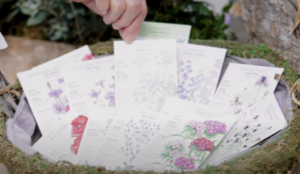Category Archives: Seeds
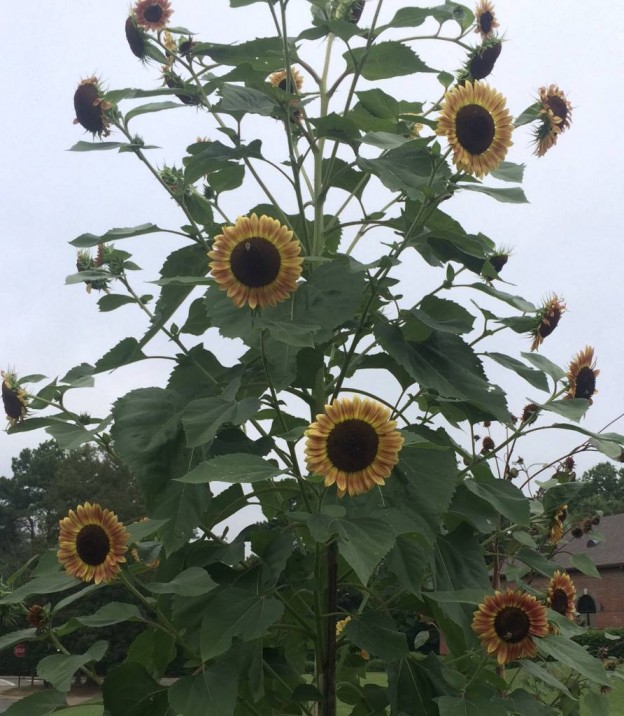
Our Seed Racks Are Full…So Much Promise In A Tiny Package!
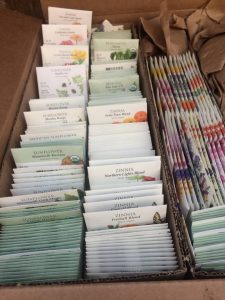 It’s always a fun day when the box of seeds arrive, their colorful packages full of promise. So why are people daunted by them? Maybe it’s the preparation of the garden beds? Or perhaps it’s the angst of sowing them just right and at the proper depth? Maybe it’s the thought of having to water them faithfully until tiny green shoots appear on dark soil?
It’s always a fun day when the box of seeds arrive, their colorful packages full of promise. So why are people daunted by them? Maybe it’s the preparation of the garden beds? Or perhaps it’s the angst of sowing them just right and at the proper depth? Maybe it’s the thought of having to water them faithfully until tiny green shoots appear on dark soil?
Whatever your reason, this year let it go and give yourself up to their promise and the wonder of watching life begin from a tiny seed to something to eat, cut, or simply enjoy in the garden. There really is no greater feeling of accomplishment than when tiny green sprouts emerge!
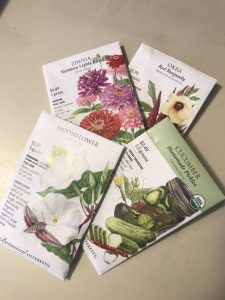 Success with spring and summer flower and vegetable seeds does require you to understand the last average frost date in your area. Here, in Birmingham, Alabama, our last average frost date is mid-April.
Success with spring and summer flower and vegetable seeds does require you to understand the last average frost date in your area. Here, in Birmingham, Alabama, our last average frost date is mid-April.
The directions on a seed packet will tell you when to sow outside, usually a number of days after the last average frost date, or they might tell you to sow the seed directly in the ground and at a certain depth. Seed packets offer a wealth of information!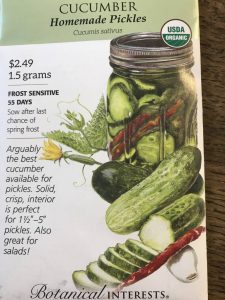
For example, the information on the cucumber packet shown here tells us that sowing outside is RECOMMENDED 1-2 weeks after the last average frost. It tell us to start them inside but that they’re sensitive to root disturbance, so if we do they should be sown in biodegradable pots that will be planted directly into the garden.
It tells us that, if we have successful germination, the seeds should emerge in 5-10 days, how deeply to sow them (1/2″), how far apart to space them, and when to thin them.
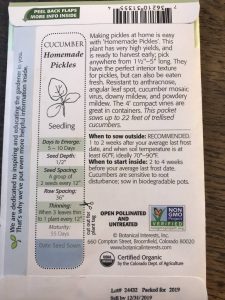 There’s even a picture of the seedling so you don’t mistake it for a weed! That’s a lot of information that will help us succeed in our seed planting venture. Some seeds need to be soaked for a length of time to soften their hard seed coating or nicked with a file to help them germinate. Read your package carefully for any specific instructions, and look on the inside for more information as well.
There’s even a picture of the seedling so you don’t mistake it for a weed! That’s a lot of information that will help us succeed in our seed planting venture. Some seeds need to be soaked for a length of time to soften their hard seed coating or nicked with a file to help them germinate. Read your package carefully for any specific instructions, and look on the inside for more information as well.
So, armed with the information on the seed packet, we know when to sow; now we need to be sure our garden beds are ready. What do we do to ensure our tiny seeds will come up? Well, the first thing to remember is that seeds need loose soil to work their way up into the light and for their roots to take hold.
The best way to accomplish this is to loosen the soil with a garden fork. Break apart large clumps and remove any old roots, sticks, or large rocks. Add soil amendments, if necessary, like PlantTone, cow manure, or topsoil and rake the soil to create an even, level surface to sow your seeds. Look at the directions on the seed packet to tell you how deeply to sow them. Some might only need to be pressed onto the top of the soil where they’ll have sunlight to germinate.
If you have very fine seed, a good method to ensure even sowing is to mix the tiny seeds with sand before sowing. For larger seeds create a furrow the right depth, set the seed in the furrow at the correct spacing, and gently cover. Finally, don’t forget to label each planting area.
After planting your seeds it’s important to water them with a fine shower of water to moisten the soil. Here’s the important trick: You must keep the seed bed moistened until the seeds begin to come up. Be careful not to dislodge them with a strong spray of water and remember that on very hot days you may need to water twice.
Seedlings need to be thinned once they’re up and growing. This is the process where you eliminate the weakest so the strongest have room to grow to their full potential. The best way to thin seedlings is to snip the ones you’re removing at soil level with your fingers or a pair of scissors. Don’t pull them as that could disturb the soil too much around those you’re allowing to stay.
All of the above information assumes you are sowing your seeds directly into a garden bed, but in some cases you might want to start them early inside. This requires either a greenhouse or grow lights or, at the very least, a very bright window and some bottom heat to aid in germination. I remember my Dad putting pots planted with tomato seeds on top of our warm furnace in Wisconsin. He’d move them into an unheated greenhouse after they’d started growing but while it was still too early to plant them in the ground.
As a general rule, don’t start seeds inside too early! Most annual vegetables can be sown inside roughly 5 weeks before the last average frost date. Again, follow all the directions on your seed packet and move them outside when the soil is warmed, usually after the last average frost date.
So, what are you waiting for? It’s time to pick out some seeds!
If you follow us on Instagram or Facebook you’ve probably seen a new series of shop videos – if not, follow us and check them out! They’re also on our YouTube channel under Oak Street Garden Shop – if you’d like to see more, subscribe!
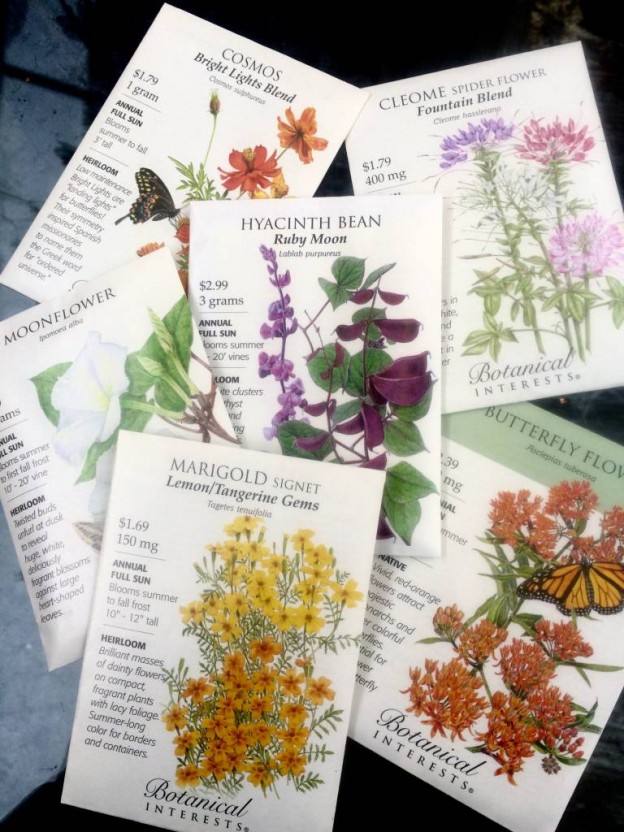
Botanical Interests Spring Seeds – So Much Promise In A Packet
On a gray, cold day in the middle of February, the promise of a beautiful spring and all the summer days to follow arrived in two nondescript boxes. Tearing them open, I looked at brightly colored seed packet after seed packet of herbs, flowers, vines, and vegetables, and began sorting them out.
This was easier said than done, as we’re still in the midst of a major rearrange of the greenhouse, moving our work/design area from one end to the other, in the process cleaning, painting, reorganizing, and generally going through the proverbial “mess before it gets into some semblance of order” phase.
Jamie and I had prepared though, setting up seed racks by the front table where our garden shop cat, Liam, likes to sleep. I pulled all the fall “cool season” seeds and set out a 50% off sale sign on them.
Purchasing them now at a discount is a smart move. Keep them cool and dry, since humidity and warmth may shorten a seed’s shelf life. Knowing this, the best way to store any seed you purchase is in plastic food storage bags, glass jars with tight fitting lids, or any other container that will stay sealed. Place them in your refrigerator (Not the freezer!) until you’re ready to use them.
Once you’ve browsed the sale seeds, don’t forget to check out this season’s selection for your summer flowers and vegetables. I’ve already set aside some of them for the Better Late Than Never Garden – assortments of tall cutting zinnias, sunflowers, tithonia (Remember the tall, beautiful orange flowers that bloomed late in the season?), spider flower, moonvine, ‘Red Burgundy’ okra (It’s ornamental and edible!) and more. I’ll be putting them in my refrigerator at home until I sow them sometime in late spring/early summer.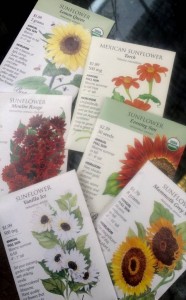
Of course there are many things that can be started inside under grow lights or in a greenhouse much earlier, and this can be a fun and educational project for anyone with children. Simply follow the directions on the seed packet to ensure success. It will say how many days to sow before or after the last average frost (For us, that magic date is April 15th.). Knowing that will help you start your seeds at just the right time.
So plant some seeds this year. You just might be surprised at what comes up!
By Kris Blevons
Our Garden – This Year It’s Full of Flowers!
Last fall we planted the garden across the street from the shop with all the combinations of pansies and violas we could pack into it, and it was beautiful until the first hot, pollen-filled days of spring arrived. Then it sat…the poor pansies getting more and more bedraggled as we got busier and busier helping folks plan and plant their own gardens and planters. Finally we had a little breathing time and were able to at least get the scraggly winter plantings pulled out; but, by then, it was already June!
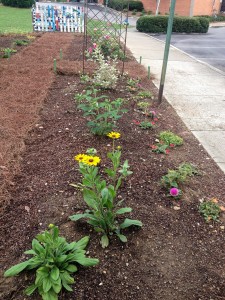
The large blooms of ‘Indian Summer’ rudbeckia already provide some color…
Clearly, something had to be done. We certainly couldn’t be a garden shop with no garden! So we began to plan our summer garden. We decided this year it would be filled with flowers and began to set some aside to plant along the edges of the four planting beds.
In the centers of the beds, we envision tall cutting zinnias, orange Mexican sunflowers (Tithonia), annual sunflowers, and nicotiana by seed (We’re keeping our fingers crossed they all come up!) and have some hibiscus planted as well.
There are two arbors in the middle of the garden. On the largest we planted hyacinth bean vine seeds on one side and a pink mandevilla vine on the other.
A red mandevilla and a moonvine are growing up the other arbor. Be sure to walk through in the early evening to watch the enormous, fragrant, pure white moonvine flowers unfurling. You can literally watch them slowly open, greeting the evening. By morning their blooms are gone – rather like a morning glory vine in reverse.
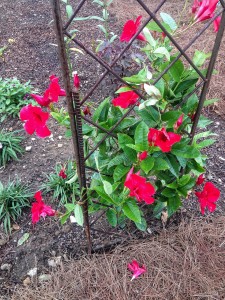
Red mandevilla…
Jay added bags of PlantTone to each bed, raked it in, added a light layer of soil conditioner, and graded the beds to prepare them for planting. Because we didn’t want to expose a lot of weed seeds to sunlight, which would cause them to begin growing, we didn’t turn the soil. As the flower seeds emerge and we’ve thinned those that need it, we’ll add more soil conditioner as a top mulch to help conserve water and keep future weeds in check.
Some of the low edging plants we used include purslane, red cuphea, mecardonia, gomphrena ‘Pink Zazzle’, and mexican heather. Plans are to also add some succulents at the front corner by the sign.
We hope everyone in the area enjoys our staff flower garden this summer. If you happen to be walking by, take a stroll along the paths, enjoy the flowers, and help pull a few weeds if you see them!
By Kris Blevons
Fall Veggie and Flower Seeds…Try Some This Year!
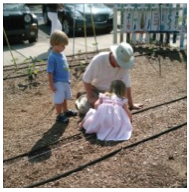
Planting seeds is a fun project!
Our fall seed selection has arrived, and many folks have already been perusing the seed rack. From radishes to radicchio, lettuces to larkspur, the selection is varied, and the package description on our Botanical Interests seed packets are fun to read too.
Additionally, I’m so pleased this company only supplies us with GMO free seed, which means none of this seed is genetically modified.
If you’re planting seeds for the first time, be sure to read the instructions on the packet. They’ll tell you how deeply to plant and how long it will take them to come up, as well as any other instructions you might need to produce a healthy plant.
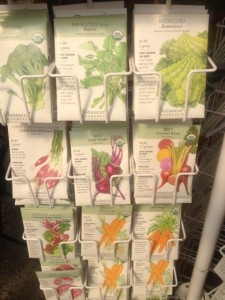
Seed packets have lots of information on them…
Remember, in Birmingham, our first average frost date is usually the beginning of November. This will help you determine the latest you can plant certain seeds.
Prepare your garden bed by pulling any old vegetation out. If you have a compost pile, everything but weeds can be put into it to decompose. Next you’ll need to loosen the soil – a garden fork works well for this. Push the fork into the soil 7″-8″ and rock it back and forth to loosen it, being sure to break up any big clumps. Many gardeners try to keep turning up the soil to a minimum, since that can bring weed seeds to the surface, providing them the light needed to germinate. Next, add 2″-4″ of soil amendments (dehydrated cow manure, Plant Tone, soil conditioner and/or your own compost) over the top and lightly fork all of it in. Rake the top of your bed to even it out and you’re ready to plant!
Watering your seed bed is important. If you’re sowing very tiny seeds, you may want to water the soil before planting. Once the seeds are sown at the proper depth, keep the soil consistently moist with gentle showers from your hose. Don’t get it too soggy or your little seeings may rot.
Seedlings of many vegetables and flowers benefit from being thinned. This term simply means taking out the smallest, weakest seedlings so one strong plant is able to grow large enough for you to eventually harvest.
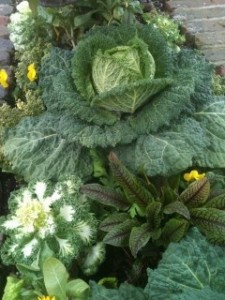
Look at that cabbage!
The easiest way to thin is simply to cut out the weakest with a pair of scissors, leaving the largest to continue growing. Talk about survival of the fittest! You could also tease the weakest seedlings out of the soil and replant in another area – the more the merrier!
Some fall vegetable seeds we have include many lettuces, chard, beets, broccoli, mustard, spinach, turnips and more. If you’d rather plant flowers, larkspur, delphinium, poppies and bachelor buttons are just some of the choices.
Doesn’t this sound like a fun and ultimately rewarding project? If you have children, find a spot in your yard for even a small garden, and start planting!
– Posted using BlogPress from my iPhone
Promise In A Packet…Seeds!
If you’ve been in recently you may have noticed the colorful seed display behind the counters.
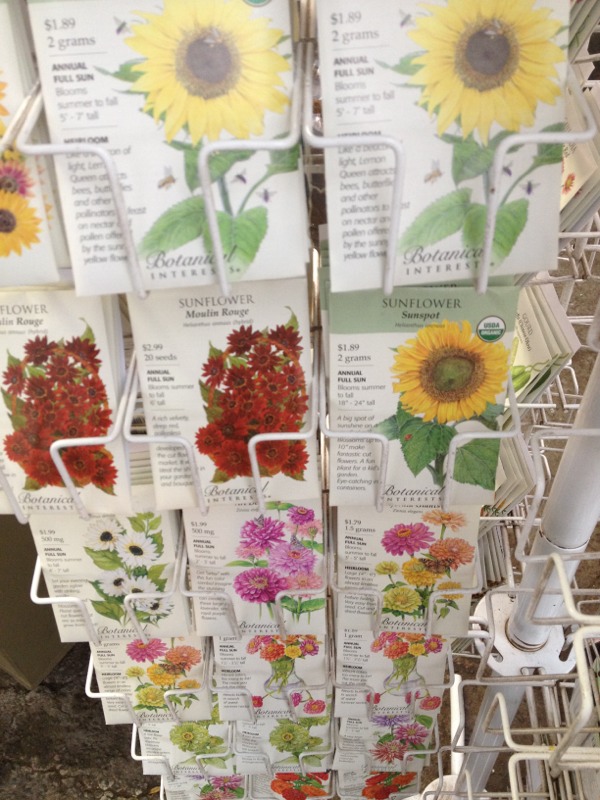
Oh the promise of seeds – those tantalizing pictures and mouthwatering descriptions of vegetables, flowers and herbs…all in a magical seed packet.
Maybe you’ve never tried to grow anything from seed. That’s ok, there’s a first time for everything! Here are some easy flowers to grow by direct sowing them right where you want them to come up in your garden: zinnias, sunflowers, cosmos, marigolds, tithonia (Mexican sunflower) and gomphrena are a few.

Seed planting is a fun project for the little ones!
Since you will be sowing these directly into the ground, you need to be sure the soil is warm enough for them, May is the perfect month to plant these. Here you can see Billy planting seeds in the garden with some little helpers in the community garden across the street last spring. Below you can see we have veggie seeds too – and plenty to choose from as you plan your summer garden!
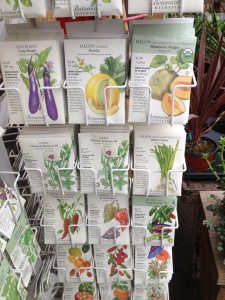
Warm season vegetable seeds…eggplant, peppers, melons and more!

